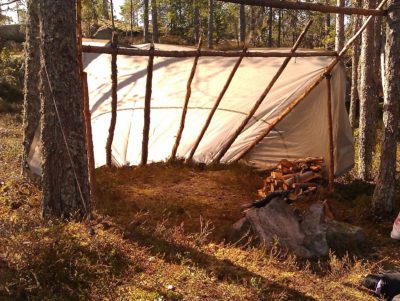
The reason I’ve taken quite the liking to studying the simple ways of bushcraft and become rather fond of a “horse-sensical” form of prepping is because survival is often dependent on our ability to boil things down.
Now, I will admit that there are certain systems and pieces of gear that we should certainly not omit from our survival plans. But when it comes to knowing how to get by in God’s country, I believe that it’s just better to know more. That way we’re not stuck in a tough situation carrying less than we’d originally hoped.
With that said, knowing how to construct a shelter is one of the most crucial skills that a survivalist can know. A successful bugout – one where everyone stays alive and well – might just come to require it.
The Secret To Starting Fires In Even The Most Extreme Conditions
For When You’re Out of Options
To begin, I’ll first say that these four shelters are primitive types, and should be used in the event that you haven’t brought your own tarp system. A tarp is simply going to be easier to set up and offers better protection from the elements.
No. 4. Lean-To

A lean-to shelter is going to be perhaps the easiest one to set up of the bunch – which means that it’s going to take you less time to get the job done before the setting sun causes you problems. If you weren’t able to bring along a headlamp, then this particular shelter is a good choice.
Essentially, a lean-to shelter is a simple structure . With practice, it can be erected quickly and offer you a heat reflector to get the most out of your fire. It also can block out a moderate rain (if the shelter is set up to shield you from the wind).
You can find a stellar tutorial on how it’s done from PracticalSurvival.com, although the picture on this page will give you a sense of what you need.
Pros: Quick setup, requires less tooling, offers some cover and can be used as a heat reflector to contain heat from your campfire (which can be amplified with a space blanket).
Cons: Won’t protect against very rainy or cold weather, waterproofing on only one side, will not efficiently trap body heat.
No. 3. A-Frame
The a-frame shelter is often the go-to for bushcrafters in the northeastern woodlands of the U.S. simply because it does just about everything a shelter should do, reasonably well. It’s also based on a simple ribbed design, so it makes for a somewhat fast setup. Yet at the same time you can add as much debris as you feel necessary for weatherproofing and heat retention.
The key here is to make sure you’ve set aside enough time to plan it out since it’s going to be a bit more complex to build than your common lean-to shelter system. The nice part about this shelter is that you can build a fire near the entrance and if you have a backstop to your firelay you can reflect that warmth inside your a-frame.
MakerMAF on Instructables has a great tutorial piece on building a-frame shelters.
Pros: Moderately easy setup, moderately sturdy against wind, protects on two sides and will offer moderate heat retention.
Cons: Will be inadequate in extreme weather conditions, takes double the set-up time as a lean-to and construction integrity depends on resources at hand.
No. 2. Wickiup
The wickiup (could also be categorically called a wigwam) is basically the granddaddy of survival shelters and is the prelude to the teepee. This shelter system can provide a more permanent residence due to its sturdy construction, heat retention, indoor heat option and overall comfort-factor. Needless to say, there are no shortage of advantages to a conically shaped shelter.
This shelter does takes coordination, time and skill to set it up in such a way that justifies building it. If anything, this would be a shelter that I’d begin building if I had another adequate shelter already in place. Because I wouldn’t want to skimp on a wickiup, I’d take multiple days to build it properly (which means that I don’t plan on going anywhere for a while).
Story continues below the video
Yet, one thing the woods teaches is that prudently applied hard work will not go without reward. Field & Stream states that a wickiup will allow you to procure fewer logs for a night’s heat, since your fire can stay inside the shelter with you.
Pros: Basically a small home, you can stand in it and keep your fire inside the shelter. It will endure wicked weather and is extremely sturdy.
Cons: Takes time, skill, energy, adequate resources on hand and should probably not be attempted if limited time and labor capacity is a factor (ie: injury, sickness, etc.)
No. 1 Debris Hut
The debris hut is certainly my favorite one of them all since it’s extremely heat-efficient, incredibly sturdy, obscenely weatherproof and is practically an igloo that’s made of indiscriminate woodland … stuff. It’s got all the strengths of the other shelters and few of their weaknesses.
Also, even though it can take a good bit of time to perfect it, this shelter can be improved over time. As you take the time to layer materials for heat retention and weatherproofing, it only gets better and stronger (which is where the wickiup tends to fall short). In fact, I’ve even seen Debris Huts that can accommodate an inside firelay, but there are some additional mods that are required before this can be done without smoking yourself from your own wilderness home.
The debris hut is like the Swiss Army Knife of shelters, simply because of its excellent versatility, flexibility, efficiency, structural integrity and comparatively easy construction process. You can find a great tutorial for building this extreme-weather shield on Wonder How To’s survival section.
Pros: Maximum heat retention, extreme weatherproofing, regional building material flexibility, comparatively easy setup and reinforceable.
Cons: Higher difficulty and more time to set up than a standard A-Frame or Lean-To, cannot stand in it like a Wickiup.
Tips for Learning to Build These Structures
I’d learn the lean-to first, since it’s the easiest shelter to build and a somewhat effective shelter is always better than no shelter at all.
Then, I’d build the debris hut and become extremely adept at putting them together quickly and constructing them well. After that I’d learn the a-frame, since those are a step better than a lean-to with a relatively small, added measure of difficulty
After you’ve master those three, then go ahead and treat yourself to a wickiup. Because sooner or later you’re going to want a place to have your friends over for roast rabbit and dandelion wine at your survival retreat.
Which survival shelter is your favorite? What would you add to the list? Share your tips in the section below:
Could You ‘Live Off The Land’ With Your Gun If Necessary? Read More Here.










